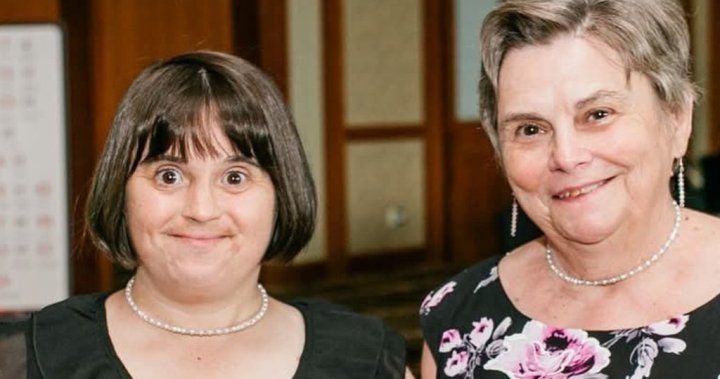Janet Charchuk knows that having Down syndrome puts her at higher risk of getting Alzheimer’s disease at a younger age than the average person.
“It is something that I do worry about at times,” she said in an interview from her home in Alberton, P.E.I.
But she’s doing everything she can to prevent it.
“Your diet, your sleep, exercise,” Charchuk said.
“(Having) friends and being social and doing brain exercises.”
Her favourite brain exercise is word searches. She also stays physically active and social, working at an equine therapy ranch, competing in the Special Olympics and serving on the board of advocacy group Down Syndrome International.
At 42, Charchuk is among the growing number of people with Down syndrome living well into adulthood. A recent study estimates there were 22,367 people with the developmental disability in Canada as of 2020 — with 30 per cent of them age 40 and older.
In Canada, “the average lifespan of someone with Down syndrome is about 60 years old,” said Dr. Brian Skotko, senior author of the study published earlier this year in the journal Genetics in Medicine.
That’s a notable increase from an average life expectancy of about 53 years of age in 1970. Back in 1950, the study said, there were an estimated 5,138 people with Down syndrome in Canada and most died as children at an average age of four. Fewer than one per cent of them survived to age 40 years and older.
Still, a 60-year life expectancy falls far short of the Canadian average of 82 years.
For people with Down syndrome, “there’s one big culprit getting in the way, and that is Alzheimer’s disease,” said Skotko.
“The number one cause of death in adults with Down syndrome are complications related to Alzheimer’s,” which could include falls, memory loss, or choking, he said.
People with Down syndrome have an extra copy of chromosome 21, which also happens to be a chromosome associated with amyloid plaque linked to Alzheimer’s disease, Skotko said.

Get weekly health news
Receive the latest medical news and health information delivered to you every Sunday.
The study is the latest in a series of country-specific efforts to get the most accurate possible estimates of the Down syndrome population — including the U.S., Australia, New Zealand and Europe — spearheaded by Skotko, who is the director of the Down syndrome program at Massachusetts General Hospital in Boston.
“People with Down syndrome, if we want them to have a voice and the right policies and the right information and supports, we need to have an accurate accounting of their numbers,” said Skotko.
Laura LaChance, a co-author of the study and the executive director of the Canadian Down Syndrome Society, said that includes understanding how many people with the disability are adults and the various medical, financial and social supports needed to help them live as long as possible and age well.
“Because individuals with Down syndrome didn’t live that long historically, the system still really treats Down syndrome as a pediatric issue, a children’s issue,” she said.
It “hasn’t kept up to date in supports or pathways or inclusive strategy that’s tailored to adults with Down syndrome,” she said.
But several doctors and advocates are hoping to change that. One big step is educating more primary-care providers about not only the link to Alzheimer’s disease, but also to screen for other conditions — including cardiovascular risks, underactive thyroid and sleep apnea — that adults with Down syndrome are particularly prone to.
“Adults with Down syndrome might not be able to communicate their symptoms as clearly or go to a doctor early. So preventive care is very important — otherwise we’ll miss those diagnoses,” said Heidi Diepstra, lead of the developmental disabilities primary care program at Surrey Place in Toronto.
Although annual health exams are no longer recommended for the general population in several provinces, they’re essential for people with Down syndrome, said Diepstra, who helped develop a specific Down syndrome “health watch” checklist posted online by the College of Family Physicians of Canada.
Primary-care providers can use the checklist to help avoid “diagnostic overshadowing,” where clinicians see symptoms in patients but just assume they are part of having Down syndrome rather than investigating further to find the underlying condition, such as depression or hypothyroidism, she said.
The checklist was first developed in 2011 and is expected to be revised by Surrey Place once more funding becomes available, Diepstra said.
Even though “anecdotally” they know some primary health-care providers are using it, it needs to be more widely incorporated into medical practice to meet the needs of patients with Down syndrome, she said.
“(We) know from research data that health disparities continue to exist for people with IDD (intellectual and developmental disabilities),” Diepstra said.
“This means we need to do more to increase the awareness and uptake of these tools with health-care providers in Canada.”
Dr. Liz Grier, a family doctor and medical director of Ongwanada Developmental Services in Kingston, Ont., said both physical and emotional care for adults with Down syndrome has improved over the years — whether they’re living with aging parents or in supportive housing — contributing to longer and healthier lives.
“There’s better involvement of both medical and social service supports in terms of engaging day programming and other activities,” she said.
But Grier also believes care for people with Down syndrome can improve further, leading to longer life expectancy.
She said in addition to primary-care providers, it’s important for family members and caregivers to be on the watch for both physical and mental health symptoms so the person with Down syndrome can be screened and treated early.
Even the high risk of Alzheimer’s disease can be managed to some degree, Grier said.
Getting enough vitamin B12 and treating sleep apnea are both medical interventions that can help, she said.
Supporting people with Down syndrome to live a “fulfilling, engaging” life is also vital in helping stave off dementia, Grier said.
“Keep the brain stimulated, keep the brain healthy with the right vitamins and nutrients that it needs, stay active from a physical health perspective … all of those pieces contribute,” she said.
Read the full article here


